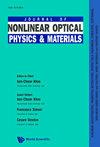Mapping the magnetocaloric effect at the microscale on a ferromagnetic shape memory alloy with infrared thermography
IF 2.3
4区 物理与天体物理
Q2 OPTICS
引用次数: 1
Abstract
An innovative study of the magnetocaloric effect (MCE) was performed by mapping the effect based on direct measurements of the temperature change during magnetic field cycles with microscopic resolution (85 μm) on a Co-doped Ni–Mn–Ga bulk sample using infrared thermography on the whole sample. The MCE maps were constructed for different sample temperatures (T sample), cycling both on heating (from 272.8 K up to T sample, with T sample ⩽ 327.0 K) and on cooling (from 340.0 K down to T sample, with T sample ⩾ 266.8 K), cycling a 1.2 T magnetic field at each T sample value. The MCE maps were calculated to evaluate the amplitude of the effect at the microscale for all T sample values. This allows to analyze the contribution of each micrometric portion of the sample to the spatially heterogeneous behavior that was found. Significant differences of the MCE on heating and cooling are present associated to inhomogeneity dynamics, mostly near the structural transformation. The amplitude of the MCE and its inhomogeneity are both much more pronounced on the heating process. On the cooling process the effect behaves quite homogeneously since the structural transformation already occurred during the cooling to reach T sample. The behavior of the MCE at selected map coordinates was scrutinized, revealing significant differences amongst sample locations. Moreover, the extreme amplitudes of MCE registered for diverse micro-regions occur at different temperatures, suggesting that the structural transformation occurs at varying temperatures and with different magnitudes. The study innovates by constructing MCE maps to evaluate minority behaviors in the MCE in contrast with the average behavior of the effect. This study displays the capability to discriminate the behavior of the transformation at the microscale.用红外热成像技术绘制铁磁形状记忆合金的微尺度磁热效应
利用红外热成像技术对共掺杂Ni-Mn-Ga样品进行了磁热效应(MCE)的创新研究,该研究基于对磁场循环期间温度变化的直接测量(微观分辨率为85 μm),对整个样品进行了红外热成像。MCE图是为不同的样本温度(T样本)构建的,在加热(从272.8 K到T样本,T样本≥327.0 K)和冷却(从340.0 K到T样本,T样本大于或等于266.8 K)时循环,在每个T样本值处循环1.2 T磁场。计算MCE图以评估所有T样本值在微观尺度上的影响幅度。这允许分析样品的每个微米部分对所发现的空间异质行为的贡献。MCE在加热和冷却方面的显著差异与非均匀性动力学有关,主要是在结构转变附近。MCE的振幅及其不均匀性在加热过程中都更为明显。在冷却过程中,由于在冷却到T样品的过程中已经发生了结构转变,因此这种效应表现得相当均匀。MCE在选定地图坐标上的行为被仔细检查,揭示了样本位置之间的显着差异。不同微区记录的MCE极端振幅发生在不同的温度,表明结构转变发生在不同的温度和不同的量级。本研究的创新之处在于通过构建MCE图来评价少数群体在MCE中的行为,并将其与平均行为的效果进行对比。该研究显示了在微观尺度上区分转化行为的能力。
本文章由计算机程序翻译,如有差异,请以英文原文为准。
求助全文
约1分钟内获得全文
求助全文
来源期刊
CiteScore
3.00
自引率
48.10%
发文量
53
审稿时长
3 months
期刊介绍:
This journal is devoted to the rapidly advancing research and development in the field of nonlinear interactions of light with matter. Topics of interest include, but are not limited to, nonlinear optical materials, metamaterials and plasmonics, nano-photonic structures, stimulated scatterings, harmonic generations, wave mixing, real time holography, guided waves and solitons, bistabilities, instabilities and nonlinear dynamics, and their applications in laser and coherent lightwave amplification, guiding, switching, modulation, communication and information processing. Original papers, comprehensive reviews and rapid communications reporting original theories and observations are sought for in these and related areas. This journal will also publish proceedings of important international meetings and workshops. It is intended for graduate students, scientists and researchers in academic, industrial and government research institutions.

 求助内容:
求助内容: 应助结果提醒方式:
应助结果提醒方式:


